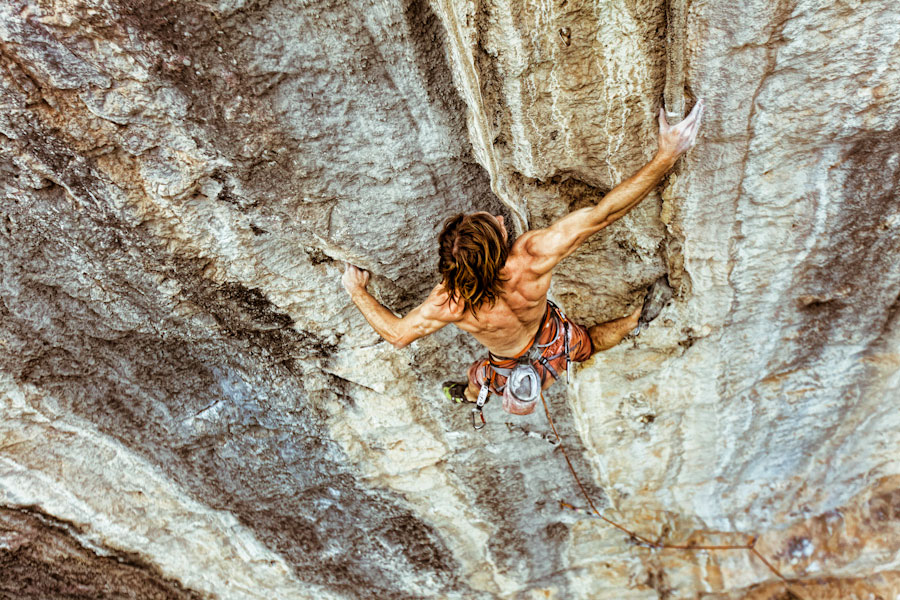
What a no-ropes rock climber can educate us about tackling our nervousness.
If Chris Sharma is frightened about something at this very second, it’s not the peak at which he’s climbing or the three-story free fall into the water under. It’s the water itself, which the locals describe as totalmente congelada—freezing chilly—and as a lot as you would possibly mentally put together for that second, you’re feeling it the second your physique slaps the floor.
Chris Sharma is shirtless in blood crimson shorts and signature yellow sneakers that, no shock, he designed himself. He appears to be like down just for a second, if something to reassess his line—his personal distinctive path to the highest. Beneath him the ocean swells. The froth surges on the rocks. He reaches again together with his free hand and dips calloused fingers right into a mesh bag of chalk hanging from his belt and resumes his climb up the face of the cliff.
Deep-water soloing is a comparatively new addition to the game of climbing. It includes ground-up free soloing (i.e., climbing with out ropes) above water, and Sharma is one among its most notable pioneers. Proper now he’s dangling a number of dozen toes above the raging Mediterranean Sea, mounting an arch often known as Es Pontàs, which stands majestic on the southeastern fringe of the Spanish island of Majorca.
Clearly the game requires Herculean energy and agility, however there’s one thing acrobatic and ape-like about Sharma’s actions. Trying up, the ascent seems unimaginable, however Sharma is sort of reckless as he scrambles up the arch, tackling a line that has by no means been achieved earlier than. He spots a slab of stone rising from the cliff face above him and grips it between white, calcified fingertips, his legs flailing over the void as they battle to search out something that may cross for a foothold. For a second his knees hug the façade, however he’s not the place he needs to be. His tendons pressure to keep up the maintain.
He eyes his salvation: a clear rock edge about two arms’ size to the appropriate. He recalibrates immediately. Sharma thrusts himself in that course however misses the meant mark and, with out warning, plummets 40 toes into the turbulent sea surging beneath him
On the age of 33, Sharma is aware of a fantastic deal about falling down and getting again up. A contemporary-day nomad, he hops from one rock to the subsequent, all the time seeking the subsequent large problem. His enjoyment comes not a lot from reaching the height because it does from discovery, exploration, and the unknown: “There [are] lots of people that possibly focus an excessive amount of on attending to the highest,” he says. “They simply wish to get to the highest and have that success, which is just too dangerous, as a result of a lot of it takes place within the strategy of engaged on it. That’s the entire lifetime of it.”
As soon as Sharma has taken on a brand new undertaking, he doesn’t plan his course and prepare elsewhere. He trains on the rock itself. “I’m not the kind who can prepare, be doing one thing now in order that in three months I’ll be sturdy sufficient to attempt a route. I simply go attempt a line one million instances. The coaching happens on the route.” For Sharma, a vital a part of the expertise is the falling down, studying from his falls, and returning to the rock face with new info and a strengthened motivation. It’s the failures and the repetition that make him the athlete that he’s.
Think about Sharma’s phrases as steering: The coaching happens on the route. Get as shut as you’ll be able to, as quickly as you’ll be able to, to the occasion you concern. Observe your abilities there. “If you first attempt [the climb], you’ll be able to’t do all of the actions, however then you definately begin piecing it collectively and figuring it out.” His tasks are psychological, he says, demanding not solely his bodily greatest but additionally supreme focus and motivation and a willingness to confront the unknown. He’s engaged in a problem that requires nice tactical talent, and he’s successful as a result of his total technique contains ideas we will all embrace:
He steps ahead and takes on the problem.
He believes he has the power to grasp the rock.
He’s prepared to be awkward and clumsy as he learns.
He expects he might be uncomfortable.
He’s prepared to expertise dramatic failure on his technique to success.
Although he may lose one thing of nice worth (his well being, his life), as soon as he has selected a climb, he doesn’t attend to that fear whereas he’s engaged within the work.
I’m hard-pressed to think about that Nervousness will proceed to dominate you if you happen to be taught to answer your fear and concern in the identical method Sharma responds to the rock. You don’t should be bodily achieved like Sharma to win this problem. However you do should tackle the same perspective and be taught to step towards the problem.
Textual content tailored from Stopping the Noise in Your Head: The New Solution to Overcome Nervousness and Fear, HCI Books, 2016.









